
Kargil District
Encyclopedia
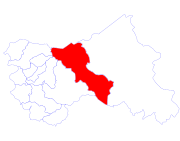

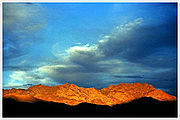
Ladakh
Ladakh is a region of Jammu and Kashmir, the northernmost state of the Republic of India. It lies between the Kunlun mountain range in the north and the main Great Himalayas to the south, inhabited by people of Indo-Aryan and Tibetan descent...
, Kashmir
Kashmir
Kashmir is the northwestern region of the Indian subcontinent. Until the mid-19th century, the term Kashmir geographically denoted only the valley between the Great Himalayas and the Pir Panjal mountain range...
, India
India
India , officially the Republic of India , is a country in South Asia. It is the seventh-largest country by geographical area, the second-most populous country with over 1.2 billion people, and the most populous democracy in the world...
. Kargil lies near the Line of Control
Line of Control
The term Line of Control refers to the military control line between the Indian- and Pakistani-controlled parts of the former princely state of Jammu and Kashmir—a line which, to this day, does not constitute a legally recognized international boundary but is the de facto border...
facing Pakistan-occupied Kashmir's Baltistan
Baltistan
Baltistan , also known as بلتیول བལིུལ་ in the Balti language, is a region in northern Pakistan which forms Gilgit-Baltistan, bordering the Xinjiang Autonomous Region of China. In addition, a part of Baltistan also falls into Jammu and Kashmir of India. It is situated in the Karakoram mountains...
to the west, and Kashmir valley to the south. Zanskar
Zanskar
Zanskar is a subdistrict or tehsil of the Kargil district, which lies in the eastern half of the Indian state of Jammu and Kashmir. The administrative centre is Padum...
is part of Kargil district along with Suru, Wakha and Dras valleys. Kargil was at the center of a conflict between India and Pakistan in 1999.
As of 2011 it is the least populous district of Jammu and Kashmir (out of 22).
Geography
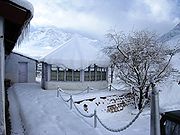
Himalayas
The Himalaya Range or Himalaya Mountains Sanskrit: Devanagari: हिमालय, literally "abode of snow"), usually called the Himalayas or Himalaya for short, is a mountain range in Asia, separating the Indian subcontinent from the Tibetan Plateau...
, giving it a cool, temperate
Temperate
In geography, temperate or tepid latitudes of the globe lie between the tropics and the polar circles. The changes in these regions between summer and winter are generally relatively moderate, rather than extreme hot or cold...
climate. Summer
Summer
Summer is the warmest of the four temperate seasons, between spring and autumn. At the summer solstice, the days are longest and the nights are shortest, with day-length decreasing as the season progresses after the solstice...
s are warm with cool nights, while winter
Winter
Winter is the coldest season of the year in temperate climates, between autumn and spring. At the winter solstice, the days are shortest and the nights are longest, with days lengthening as the season progresses after the solstice.-Meteorology:...
s are long and cold with temperatures often dropping to −40 C with recorded temperatures of −60 C in the tiny town of Dras
Dras
Dras is a town in the Kargil District of Jammu and Kashmir, India. It is often called 'The Gateway to Ladakh'. The town shot into prominence in the summer of 1999 following Pakistani-backed incursions into Jammu and Kashmir...
, situated some 56 km (34.8 mi) from the Kargil town. The Zanskar plateau
Plateau
In geology and earth science, a plateau , also called a high plain or tableland, is an area of highland, usually consisting of relatively flat terrain. A highly eroded plateau is called a dissected plateau...
is even colder, making it thus a near-uninhabitable place for humans, except for the hardy Khampas. The entire Kargil district is spread over 14086 km² (5,438.6 sq mi). The Suru River flows through the district.
National Highway 1D
National Highway 1D (India)
National Highway 1D , also known as Srinagar-Leh Highway, is a National Highway entirely within the state of Jammu & Kashmir in North India that connects Srinagar to Leh in Ladakh. It is one of the only two roads that connect Ladakh with the rest of India, the other being Leh-Manali Highway...
, connecting Srinagar
Srinagar
Srinagar is the summer seasonal capital of Jammu and Kashmir. It is situated in Kashmir Valley and lies on the banks of the Jhelum River, a tributary of the Indus. It is one of the largest cities in India not to have a Hindu majority. The city is famous for its gardens, lakes and houseboats...
to Leh, cuts through Kargil. This highway is typically open for traffic only from June to mid-November due to heavy snowfall at the Zoji La
Zoji La
Zoji La is a high mountain pass in India, located on the Indian National Highway 1 between Srinagar and Leh in the western section of the Himalayan mountain range. Though often referred to as Zojila Pass in the foreign press, the correct English translation is Zoji Pass or simply Zojila, since...
, but in recent years it has been opened before June. Kargil is located 204 km (126.8 mi) from the capital city of Srinagar
Srinagar
Srinagar is the summer seasonal capital of Jammu and Kashmir. It is situated in Kashmir Valley and lies on the banks of the Jhelum River, a tributary of the Indus. It is one of the largest cities in India not to have a Hindu majority. The city is famous for its gardens, lakes and houseboats...
. There is a partially paved road—the first 40 kilometres (24.9 mi) or so—leading from Kargil south to Zanskar
Zanskar
Zanskar is a subdistrict or tehsil of the Kargil district, which lies in the eastern half of the Indian state of Jammu and Kashmir. The administrative centre is Padum...
. Total distance to Zanskar is nearly 220 km (136.7 mi), which is again open only from June to September. The region has recently been opening to tourists, with steps a travel hub by the Indian Government. Recently, both India and Pakistan have considered linking the Pakistan town of Skardu
Skardu
Skardu , is the main town of the region Baltistan and the capital of Skardu District, one of the districts making up Pakistan's Gilgit Baltistan....
with Kargil via a bus route to facilitate free movement of Kashmiris in the area.
Demographics

2011 census of India
The 15th Indian National census was conducted in two phases, houselisting and population enumeration. Houselisting phase began on April 1, 2010 and involved collection of information about all buildings...
has a population
Demographics of India
The demographics of India are inclusive of the second most populous country in the world, with over 1.21 billion people , more than a sixth of the world's population. Already containing 17.5% of the world's population, India is projected to be the world's most populous country by 2025, surpassing...
of 143,388 , roughly equal to the nation of Saint Lucia
Saint Lucia
Saint Lucia is an island country in the eastern Caribbean Sea on the boundary with the Atlantic Ocean. Part of the Lesser Antilles, it is located north/northeast of the island of Saint Vincent, northwest of Barbados and south of Martinique. It covers a land area of 620 km2 and has an...
. This gives it a ranking of 603rd in India (out of a total of 640
Districts of India
A district is an administrative division of an Indian state or territory. Districts are further subdivided, in some cases into Sub-Divisions, and otherwise directly into tehsils or talukas.District officials include:...
). The district has a population density of 10 PD/sqkm . Its population growth rate
Family planning in India
Family planning in India is based on efforts largely sponsored by the Indian government. In the 1965-2009 period, contraceptive usage has more than tripled and the fertility rate has more than halved , but the national fertility rate is still high enough to cause long-term population growth...
over the decade 2001-2011 was 20.18 %. Kargil has a sex ratio
Sex ratio
Sex ratio is the ratio of males to females in a population. The primary sex ratio is the ratio at the time of conception, secondary sex ratio is the ratio at time of birth, and tertiary sex ratio is the ratio of mature organisms....
of 775 females
Women in India
The status of women in India has been subject to many great changes over the past few millennia. From equal status with men in ancient times through the low points of the medieval period, to the promotion of equal rights by many reformers, the history of women in India has been eventful...
for every 1000 males, and a literacy rate
Literacy in India
Literacy in India is key for socio-economic progress, and the Indian literacy rate grew to 74.04% in 2011 from 12% at the end of British rule in 1947. Although this was a greater than sixfold improvement, the level is well below the world average literacy rate of 84%, and India currently has the...
of 74.49 %.
Of total population, 80% are Muslim 95,963, of which 73% follow Shia Islam. Most of the district's Muslims are found in Kargil town
Kargil town
Kargil is a town, which serves as the headquarters of Kargil District of Ladakh in the state of Jammu and Kashmir in India. It is the second largest town in Ladakh after Leh...
, Drass, and the lower Suru valley. Of the remainder 15% are followers of Tibetan Buddhism
Tibetan Buddhism
Tibetan Buddhism is the body of Buddhist religious doctrine and institutions characteristic of Tibet and certain regions of the Himalayas, including northern Nepal, Bhutan, and India . It is the state religion of Bhutan...
and Bön mostly found in Zanskar
Zanskar
Zanskar is a subdistrict or tehsil of the Kargil district, which lies in the eastern half of the Indian state of Jammu and Kashmir. The administrative centre is Padum...
with small populations in the upper Suru valley (Rangdum) and around Shergol and Mulbekh. Another 4% of the population follow Hinduism
Hinduism
Hinduism is the predominant and indigenous religious tradition of the Indian Subcontinent. Hinduism is known to its followers as , amongst many other expressions...
and Sikhism
Sikhism
Sikhism is a monotheistic religion founded during the 15th century in the Punjab region, by Guru Nanak Dev and continued to progress with ten successive Sikh Gurus . It is the fifth-largest organized religion in the world and one of the fastest-growing...
.
Much of Kargil population is inhabited by the Burig
Burig
The Burig, or Purik, are another group of Tibetan Muslims with small Dardic admixture, who live south of the Balti in Ladakh. Most of them live in Ladakh and Baltistan, especially in Kargil, although significant numbers reside in Leh....
and Balti people of Tibetan
Tibetan people
The Tibetan people are an ethnic group that is native to Tibet, which is mostly in the People's Republic of China. They number 5.4 million and are the 10th largest ethnic group in the country. Significant Tibetan minorities also live in India, Nepal, and Bhutan...
origin (converting from Buddhism to Islam in the 16th Century) and have intermingled with the Dard
Dard people
The Dards are a group of people defined by linguistic similarities, and not common ethnicity, predominantly found in Eastern Afghanistan, in the Indian State of Jammu and Kashmir and in the Northern Areas and North West Frontier Province of Pakistan...
, Mon and other Aryan people. The mainly Muslim Dards inhabit the valley of Drass and speak Shina
Shina
Shina can refer to:* Shina , a Japanese term for mainland China* Shina , Shina Gado, a character from the Bloody Roar video game series* Shina people, Dardic people of Pakistani Kashmir* Shin of Hindukush...
, a small number of Buddhist Dard
Dard
-People:* Khwaja Mir Dard, 18th century Urdu poet.* Dard Hunter, born William Joseph Hunter , an American authority on printing, paper, and papermaking—especially by hand....
, known as Brokpa
Brokpa
The Brokpa are a small community of Dard people residing in the Dha-Hanu valley about 163 km southwest of Leh in Ladakh. They are thought by some to be the purist descendants of the ancient Indo-Europeans....
, inhabit the Dha-Hanu region near the Lamayuru
Lamayuru
Lamayuru or Yuru Gompa is a Tibetan Buddhist Gompa in Kargil District, Western Ladakh, situated on the Srinagar - Kargil - Leh road 15 km east of the Fotu La, at a height of 3,510 m.-History:A. H...
monastery. Some Arghons
Arghons
The Arghons are a small community of descendants of immigrants from Yarkand and Kashmir that have intermingled with the local Ladakhi community, residing mainly in Leh and Kargil towns of Ladakh in the state of Jammu & Kashmir in India...
and Shina
Shina
Shina can refer to:* Shina , a Japanese term for mainland China* Shina , Shina Gado, a character from the Bloody Roar video game series* Shina people, Dardic people of Pakistani Kashmir* Shin of Hindukush...
are also settled in Kargil Town.
Languages
Vernaculars include BaltiBalti language
Balti is a language spoken in Baltistan, in Gilgit-Baltistan of Pakistan and adjoining parts of Ladakh. Baltistan, before 1948, was part of Ladakh province. The Balti language is a dialect of the Ladakhi language, a form of Tibetan. It is mutually intelligible with Ladakhi proper and Burig...
, written in both the Arabic and Devanagari scripts and spoken by over 300 000, mainly in Pakistan.
Culture
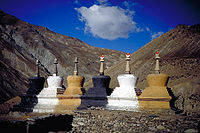
Marsia
Marsiya is an elegiac poem written to commemorate the martyrdom and valour of Hussain and his comrades of the Karbala...
s and qasida
Qasida
The qaṣīdaᵗ , in Arabic: قصيدة, plural qasā'id, قــصــائـد; in Persian: قصیده , is a form of lyric poetry that originated in preIslamic Arabia...
s. At least until recently, some Kargilis, especially those of the Agha families descendants of Syed
Syed
Syed is a masculine given name derived from the title Sayyid, it is not to be confused with the similar looking name Sayid...
preachers who were in a direct line descent from the Prophet Muhammad
Muhammad
Muhammad |ligature]] at U+FDF4 ;Arabic pronunciation varies regionally; the first vowel ranges from ~~; the second and the last vowel: ~~~. There are dialects which have no stress. In Egypt, it is pronounced not in religious contexts...
, were sent to Iraq
Iraq
Iraq ; officially the Republic of Iraq is a country in Western Asia spanning most of the northwestern end of the Zagros mountain range, the eastern part of the Syrian Desert and the northern part of the Arabian Desert....
for their education.
Social ceremonies such as marriages still carry many customs and rituals which are common to both the Muslims and Buddhists. Among the two districts of Ladakh, Kargil has a more mixed ethnic population and thus there are more regional dialects spoken in Kargil as compared to Leh. Local folk songs which are called rgya-glu and balti ghazals
Ghazal
The ghazal is a poetic form consisting of rhyming couplets and a refrain, with each line sharing the same meter. A ghazal may be understood as a poetic expression of both the pain of loss or separation and the beauty of love in spite of that pain. The form is ancient, originating in 6th century...
are still quite popular and are performed enthusiastically at social gatherings. The J&K tourism ministry annually organises festivals in which various programmes are organised to highlight the culture so as to boost the tourism industry in the district. However, the tourism industry is still undeveloped despite attractive natural as well as rich cultural resources due to bad infrastructure and severe accommodation problems.
History
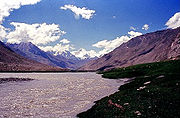
Castle
A castle is a type of fortified structure built in Europe and the Middle East during the Middle Ages by European nobility. Scholars debate the scope of the word castle, but usually consider it to be the private fortified residence of a lord or noble...
and rKil means center thus a place between castles as the place lay between many kingdoms
Monarchy
A monarchy is a form of government in which the office of head of state is usually held until death or abdication and is often hereditary and includes a royal house. In some cases, the monarch is elected...
. The competing theory is that Kargil has been derived from the words "Gar" and "Khil". Gar in local language mean ‘Anywhere’ and Khil means a central place where people could stay.
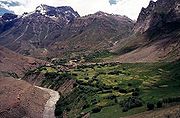
Partition of India
The Partition of India was the partition of British India on the basis of religious demographics that led to the creation of the sovereign states of the Dominion of Pakistan and the Union of India on 14 and 15...
when the issue of Kashmir became the focal point and resulted in the Indo-Pakistani War of 1947
Indo-Pakistani War of 1947
The India-Pakistan War of 1947-48, sometimes known as the First Kashmir War, was fought between India and Pakistan over the princely state of Kashmir and Jammu from 1947 to 1948. It was the first of four wars fought between the two newly independent nations...
. There were pitched battles fought around Kargil which saw the entire area including Drass and Zoji La Pass initially coming under Pakistan control before most of it being reclaimed by Indian troops by November 1948. It remained with India after the ceasefire. It again saw some action in the Second Kashmir War with India managing to wrest back the reminder of the Kargil area twice. The first capture was on May 17, 1965, when skirmishes broke out in Rann of Kutch
Rann of Kutch
The Great Rann of Kutch, also called Greater Rann of Kutch or just Rann of Kutch , is a seasonal salt marsh located in the Thar Desert in the Kutch District of Gujarat, India and the Sindh province of Pakistan....
, and India retaliated in the Kashmir sector. However, this had to be returned as per UNMOGIP treatise. On August 15, the same year Kargil fell to Indian forces, though it was once again returned as part of the Tashkent Agreement. However in the Indo-Pakistani War of 1971
Indo-Pakistani War of 1971
The Indo-Pakistani War of 1971 was a military conflict between India and Pakistan. Indian, Bangladeshi and international sources consider the beginning of the war to be Operation Chengiz Khan, Pakistan's December 3, 1971 pre-emptive strike on 11 Indian airbases...
the entire Kargil region including key posts was captured by Indian troops under leadership of Col. Chewang Rinchen
Chewang Rinchen
Colonel Chewang Rinchen MVC , SM was an officer in the Indian Army from the Ladakh region of Jammu and Kashmir.Rinchen joined the Nubra Guard in 1948, and served in the Indo-Pakistani War of 1947 alongside Indian Army units...
. In order to straighten out the line of control in the area, the Indian Army launched night attacks when the ground temperatures sank to below -17º and about 15 enemy posts located at height of 16,000 feet and more were captured. After Pakistan
Pakistan
Pakistan , officially the Islamic Republic of Pakistan is a sovereign state in South Asia. It has a coastline along the Arabian Sea and the Gulf of Oman in the south and is bordered by Afghanistan and Iran in the west, India in the east and China in the far northeast. In the north, Tajikistan...
forces lost the war and agreed to the Shimla Agreement, Kargil and other strategic areas nearby remained with India. Kargil became a separate district in the Ladakh region during the year 1979 when it was bifurcated from the Leh district.
The area shot into the spotlight in spring of 1999, when under a covert plan hatched by the then Army Chief
Chief of Army Staff of the Pakistan Army
The Chief of Army Staff of Pakistan Army, shortly abbreviated as COAS, is the highest staff post in the Pakistan Army, held by the senior 4-star rank officer. It is the highest and most prestigious 4-star assignment, unless the 4-star officer is appointed as the Chairman of the Joint Chiefs of...
Pervez Musharraf
Pervez Musharraf
Pervez Musharraf , is a retired four-star general who served as the 13th Chief of Army Staff and tenth President of Pakistan as well as tenth Chairman of the Joint Chiefs of Staff Committee. Musharraf headed and led an administrative military government from October 1999 till August 2007. He ruled...
, armed infiltrators from Pakistan, aided by the Pakistani army, occupied vacant high posts belonging to India in the Kargil and Drass regions. The result was a limited scale conflict (Kargil War
Kargil War
The Kargil War ,, also known as the Kargil conflict, was an armed conflict between India and Pakistan that took place between May and July 1999 in the Kargil district of Kashmir and elsewhere along the Line of Control...
) between both nuclear equipped nations that ended with India regaining the Kargil region through military power and diplomatic pressure.
Administration
Kargil district consists of 9 blocks: Drass, KargilKargil
' :* Kargil district, in Ladakh, Indian-administered Kashmir* Kargil town, the chief town of the district* Kargil War, a 1999 armed conflict between India and Pakistan in the Kargil district...
, Shargole, Shaker-Chiktan, Gund Mangalpur- Trespone, Sankoo
Sankoo
Sankoo is a township 42 km south of Kargil located in a bowl shaped valley drained by large tributary streams of the Suru River, the Kartse and the Nakpochu.The village is featured as the richest green flourishing and verdant valley throughout the entire region of Laddakh and hence the bowl...
, Taisuroo, Zanskar
Zanskar
Zanskar is a subdistrict or tehsil of the Kargil district, which lies in the eastern half of the Indian state of Jammu and Kashmir. The administrative centre is Padum...
, Lungnuk. Each block consists of a number of panchayats.
Politics
Kargil District has two assembly constituencies, Zanskar and Kargil.Ladakh Autonomous Hill Development Council (LAHDC) Kargil election was held in September 2008. For a smooth conduct of elections for the LAHDC Kargil, as many as 892 polling staff and more than 1,000 police personnel including para military forces have been deployed in Kargil district. Satesh Nehru is the present District Development Commissioner Kargil.
Autonomous Hill Council
Leh District is administered by an elected body known as the Ladakh Autonomous Hill Development Council, Kargil. The LAHDC-K was established in 2003.Further reading
- Ghulam Mohiuddin Dar. Kargil: Its social, culture, and economic history.
- Kargil : The Important Trade Transit of Yesteryears, People & Society
External links
- "District Kargil", Official Kargil Site
- Ladakh Autonomous Hill Development Council, Kargil
- Virtual Tour of Jammau & Kashmir
- "Pakistan's Northern Areas dilemma", BBC
- "Ladakh....Kargil"
Literature
- Shireen M. Mazari, The Kargil Conflict, 1999: Separating Fact from Fiction, The Institute of Strategic Studies, Islamabad (2003) ISBN 9698772006

